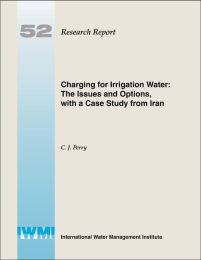Charging for Irrigation Water: The Issues and Options, with a Case Study from Iran.
Citation:
Perry, C. J. 2001. Charging for irrigation water: The issues and options, with a case study from Iran. Colombo, Sri Lanka: IWMI. v, 17p. (IWMI Research Report 52) [doi: 10.3910/2009.057]
Abstract
Inadequate funding for maintenance of irrigation works and emerging shortages of water are prevalent. The use of water charges to generate resources for maintenance and to reduce demand is widely advocated. Examples from other utilities, and from the domestic/industrial sectors of water supply suggest the approach could be effective.
In developing countries, the facilities required for measured and controlled delivery of irrigation are rarely in place, and would require a massive investment in physical, legal and administrative infrastructure.
To be effective in curtailing demand, the marginal price of water must be significant. The price levels required to cover operation and maintenance (O&M) costs are too low to have a substantial impact on demand, much less to actually bring supply and demand into balance. On the other hand, the prices required to control demand are unlikely to be within the politically feasible range.
Furthermore, water supplied is a proper measure of service in domestic and industrial uses. But in irrigation, and especially as the water resource itself becomes constrained, water consumption is the appropriate unit for water accounting. This is exceptionally difficult to measure.
An alternative approach to cope with shortage would focus on assigning volumes to specific uses–effectively rationing water where demand exceeds supply. This approach has a number of potential benefits including simplicity, transparency, and the potential to tailor allocations specifically to hydrological situations, particularly where salinity is a problem.
Data from Iran are presented to support these contentions.
ISBN 92-9090-427-5
ISSN 1026-0862


